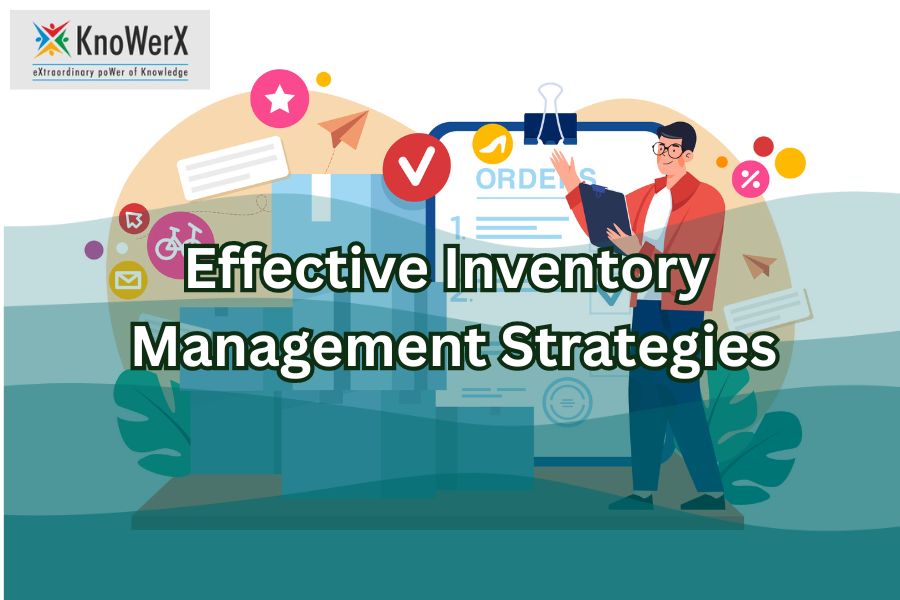Inventory Management Strategies to Boost Efficiency

Achieving Peak Efficiency with Advanced Inventory Management Strategies KnoWerX is an industry leader in Supply Chain Management Training. Through our Professional Training programs and high-quality education, we empower and evolve professionals toward success and excellence. With over 32 years of collective experience, we have been in the education & consultancy field for 25+ years, working with and training large companies in India and abroad. We are committed to providing you with the absolute best quality education at the best price possible in the Industry! KnoWerX is your one-stop destination for learning best practices, acquiring domain knowledge, and gaining relevant certification for professional growth. To help you excel in inventory management, here are some effective Inventory Management Strategies: Implementing Cycle Counting Cycle counting is a continuous inventory auditing process where a small subset of inventory is counted on a regular basis. This method helps maintain accurate inventory records without the disruption of a full physical inventory count. By regularly verifying inventory levels, businesses can quickly identify and address discrepancies, ensuring data integrity. Utilize Inventory Management Software Investing in robust inventory management software is crucial. These tools offer real-time tracking, forecasting, and analytics, enabling more informed decision-making. Automation reduces human error and frees up valuable time for more strategic tasks. Modern software solutions also integrate seamlessly with other business systems, providing a holistic view of operations and facilitating better coordination across departments. Conduct Regular Audits Regular inventory audits are essential to maintaining accuracy. Physical counts should be matched with system records to identify discrepancies. Regular audits help in detecting issues early, preventing stockouts or overstock situations. By establishing a consistent audit schedule, companies can ensure ongoing accuracy and build trust in their inventory data, which is critical for strategic planning and decision-making. Adopt ABC Analysis ABC Analysis categorizes inventory into three classes: A (high value, low quantity), B (moderate value, moderate quantity), and C (low value, high quantity). This classification helps prioritize management efforts and resources, focusing on the most critical items. By concentrating on high-value items, businesses can optimize resource allocation, reduce carrying costs, and enhance overall inventory performance. Optimize Order Quantities Economic Order Quantity (EOQ) models help in determining the optimal order size that minimizes total inventory costs, including holding, ordering, and shortage costs. This balance ensures that you order just enough to meet demand without overstocking. Utilizing EOQ models can also lead to more predictable cash flow and better financial planning, as inventory costs become more manageable and predictable. Strengthen Supplier Relationships Strong relationships with suppliers can lead to better terms, quicker restock times, and improved reliability. Good communication ensures that any supply chain disruptions are swiftly addressed, keeping inventory levels stable. Building strategic partnerships with key suppliers can also result in collaborative planning and shared benefits, such as cost savings and innovation opportunities. Implement Demand Forecasting Accurate demand forecasting is fundamental for effective inventory management Strategies. Using historical data and market analysis, businesses can predict future demand and adjust inventory levels accordingly, reducing the risk of stockouts or overstock. Incorporating advanced forecasting techniques, such as machine learning algorithms, can further enhance accuracy and responsiveness to market trends. Lean Inventory Practices Adopting lean inventory practices focuses on reducing waste and improving efficiency. Techniques such as continuous improvement (Kaizen) and value stream mapping can help streamline inventory processes. Emphasizing lean principles fosters a culture of efficiency and innovation, driving ongoing improvements in inventory management Strategies and overall operational performance. Employee Training Well-trained staff are crucial for effective inventory management. Regular training ensures that employees are knowledgeable about the latest Inventory Management Strategies and tools, leading to better performance and efficiency. Investing in employee development also enhances job satisfaction and retention, contributing to a more skilled and motivated workforce. Certified Inventory Management Officer (CIMO) Course Enhance your skills with KnoWerX’s Certified Inventory Management Officer (CIMO) course. This program provides comprehensive training on advanced inventory management techniques, preparing you for the complexities of modern supply chain management. By completing the CIMO certification, professionals can gain a competitive edge, demonstrating their expertise and commitment to excellence in inventory management Strategies. Frequently Asked Questions End Notes By implementing these Inventory Management Strategies, you can significantly boost efficiency, reduce costs, and improve overall supply chain performance. KnoWerX is here to support your professional growth with top-quality education and training in inventory management. For more information about our courses, including the CIMO certification, visit our website or contact us today! Image Reference: Freepik Disclaimer: All trademarks, logos, and brand names are the property of their respective owners. All company, product, and service names used in this website are for identification purposes only. Use of these names, trademarks, and brands does not imply endorsement.
